Last updated on Oct 15, 2025
4 Free Book Templates: Which Is Right For You?
Martin Cavannagh
Head of Content at Reedsy, Martin has spent over eight years helping writers turn their ambitions into reality. As a voice in the indie publishing space, he has written for a number of outlets and spoken at conferences, including the 2024 Writers Summit at the London Book Fair.
View profile →So you finished your manuscript but you aren’t sure how to turn your draft into a print-ready file? To refine your book for publication, you’ll need to take care of its interior design (also known as typesetting) so that each page is professionally formatted.
For authors on a budget, using book templates available online can be a practical and easy solution — though for graphically complex projects, you should ideally hire a typesetter.
In this post, we’ll share four services offering free book templates, and help you decide which one is the right one for you.
Here is the TL;DR:
|
📖 Template service |
🏆 Best for |
✅ Key pros |
❌ Key cons |
|
Reedsy Studio |
Fiction and non-fiction writers who want a press-ready PDF in minutes |
One-click browser typesetting and export |
Limited style customisation |
|
Amazon KDP (Word) |
Authors who love to use Word and publish exclusively on Amazon |
Seamless with KDP; multilingual |
Must tweak styles manually; little room for fancy layouts |
|
48 Hour Books |
US and Canadian authors printing through 48 Hour Books |
Front-matter placeholders included |
Company promo scattered through template |
|
BookBaby |
DIYers happy to define every margin and style from scratch |
Good guidance sheets for all kinds of formats |
The ‘template’ leaves all formatting work to you |
1. Reedsy Templates
📌 Key Features:
- Platform: Free web-based editor (no downloads required)
- Import Options: Copy-paste or import from any writing software
- Templates: 3 free professional templates (Classic, Romance, Reedsy)
- Trim Sizes: 4 popular US sizes including Trade (6" x 9") and Pocket (4.25" x 6.87")
- Export Formats: Print-ready PDF, reflowable ebook, and .docx backup
Most of the sites we mention in this guide offer downloadable templates you can edit, but it's actually easier to copy-paste and edit your manuscript into a free book formatting app — Reedsy Studio 一 and then download a print-ready file.
Q: What should I do if someone has already written a book with my idea?
Suggested answer
Write it anyway!
The market for books is huge and each writer's voice is unique. You will have a different way of presenting the informaiton or telling the story, even if it's similar to someone else's.
Alice is available to hire on Reedsy ⏺
Write a better book. There are many books written about the same topic, same ideas, same plots. You can't protect an idea, only the written expression of that idea. Go write your own book that is thoughtful, well-written, and thorough. A good book will find an audience.
Maria is available to hire on Reedsy ⏺
To get started, log in to Reedsy and click on the ‘Book’ section. There, you can either create a new project, copying your text directly into the editor, or import your existing manuscript from any writing software.
The formatting in the original manuscript will carry over, and your book will be ready to export in just a few minutes, complete with a title page, chapter headings, page numbers, and so on.
You’ll also be able to add photos, images, endnotes, and scene breaks.
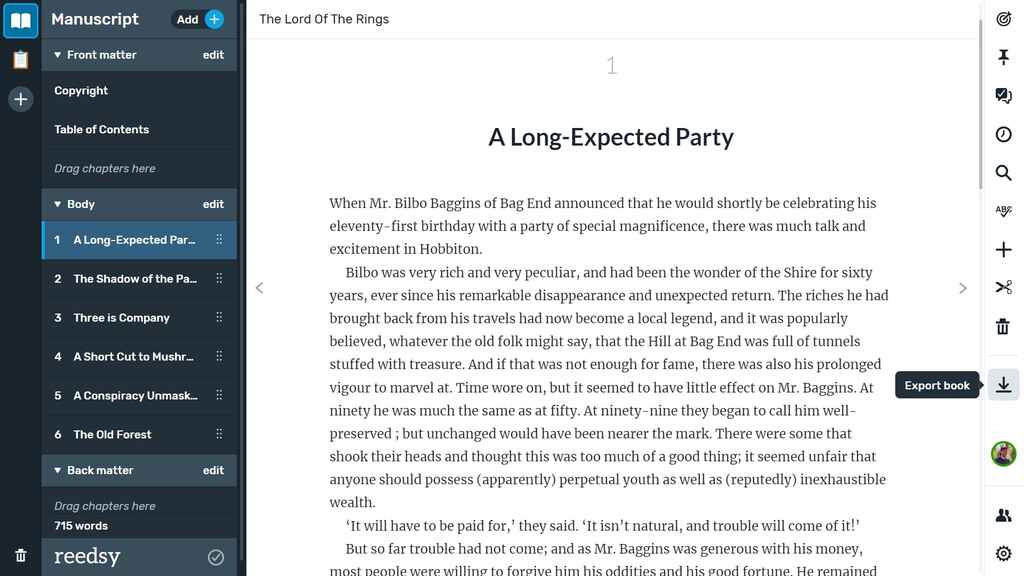
The left menu allows you to edit your copyright page, adding information such as the year of publication, the ISBN number, and collaborators, as well as adding clauses that help protect you and your book. The page will be automatically generated once you export the book, alongside with a table of contents that you can also edit from the left menu.
Q: What are the most effective ways for authors to begin monetizing their writing, particularly in the early stages of their career?
Suggested answer
At the beginning of your writing career, the best way to turn a profit is to be thoughtful and innovative when looking at your work.
Many new writers begin with self-publishing novellas or ebooks, which are inexpensive to produce and can be distributed to readers in rapid order.
Platforms like Smashwords or Kindle Direct Publishing permit the earning of royalties as well as developing a reader base.
Short stories appearing in literary magazines, anthologies, or contest publications also generate income and exposure.
Besides publishing, the majority of authors offer ancillary services—blogging, freelance, or ghostwriting—to generate a reliable flow of income and hone their writing skills.
Achievement in the beginning more likely comes from stability, reader engagement, and smart marketing: building a mailing list, establishing an internet presence, and cooperating with specialty communities relevant to your genre.
Money-making is never instant, but every action generates momentum toward a lucrative writing career.
John is available to hire on Reedsy ⏺
Take advantage of every single opportunity that comes your way in the beginning. Don't be too picky. If the front door is locked, go in the side door. Or find a window. I had great luck with blind queries in the beginning and that was before email, kids. I built many relationships that way, and most of all, keep believing in your talent, be agile, be diligent, and above all LEARN HOW TO SELL YOURSELF.
Bev is available to hire on Reedsy ⏺
If you are a non-fiction author you can use your book as a platform to get speaking engagements even before your book is published. Once it is published, ask the business you are speaking for to purchase books for each of the conference attendees and then include this purchase in your speaking "package."
Melody is available to hire on Reedsy ⏺
If by "best," we mean "fastest," then self-publishing is the way to go, since there're no gatekeepers, meaning no wait time. As soon as your book's done, you can get it up for sale. But if we mean best as in "long-term for your career," that becomes a fuzzier proposition because you need to weight the wait time, rejection, potential rewrites/edits, and possibility of never having something accepted inherent in traditional publishing against the prestige that still comes with making it into that world. It also depends what level of control you want for your work. You obviously get much more with self-publishing, but perhaps you'd benefit from the edit you might get from an editor at a legacy press. Lots of variables here, but my advice is always to be honest with yourself regarding your goals.
Legacy prestige is great and all—and, if it goes well, can be much more lucrative—but there's a lot to be said for having full control of your product.
Brett is available to hire on Reedsy ⏺
When you’re ready to download the file, click ‘Export book’ on the right sidebar. This is where you’ll be able to choose your preferred book template. Reedsy Studio offers three free templates — Classic, Romance, and Reedsy — which differ in font type and page layout, and are typeset to industry standards size.
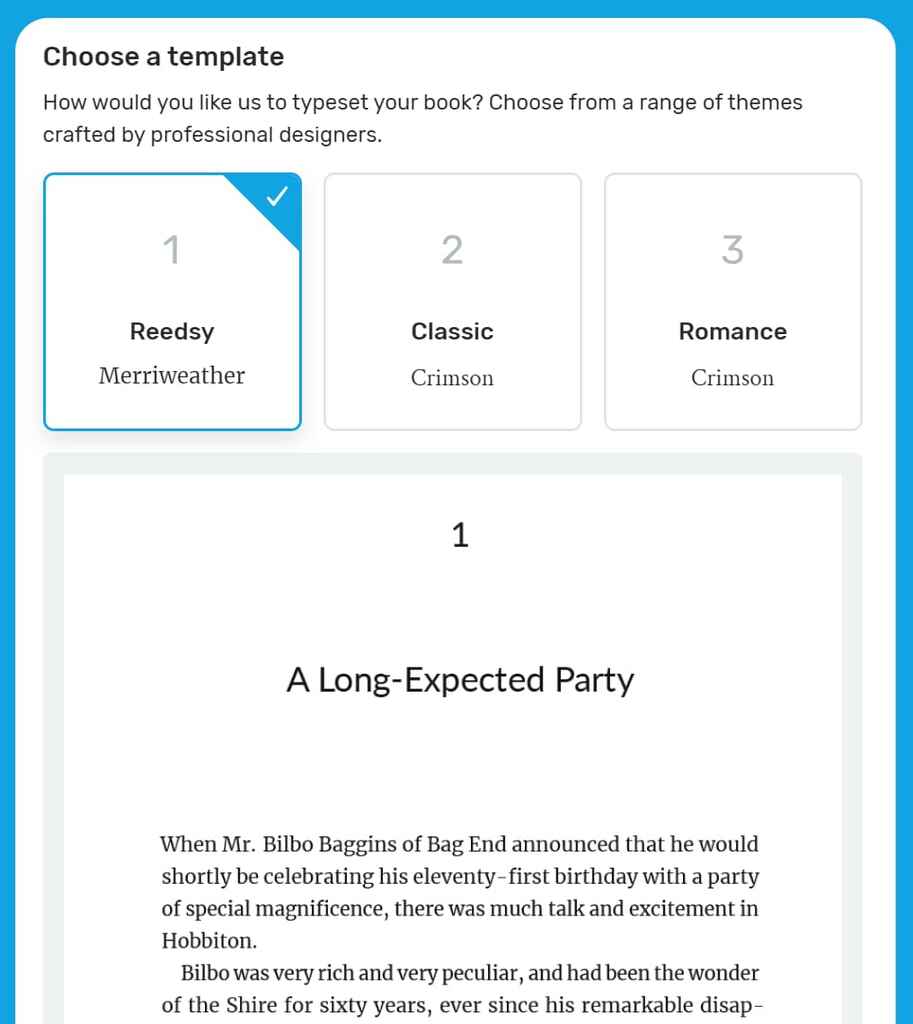
The Reedsy template features sans-serif headings and is suitable for all genres, though it is particularly suitable for nonfiction. The Classic template sports serif headings and works well with many genres, especially fiction or narrative nonfiction, which is a true story written in the style of a fiction novel. The Romance template is slightly more elaborate and specifically developed for romance titles or for writers who want something a bit more embellished.
Before downloading the template, you can choose your preferred trim size among the 4 most popular ones in the US.
- Trade (6” x 9”)
- Digest (5.5” x 8.5”)
- Reedsy Standard (5” x 8”)
- Pocket (4.25” x 6.87”)
Then hit ‘Export book’ and you’ll get a perfectly reflowable ebook version as well as a print-ready PDF file which you can use with any print-on-demand or offset printing service, which offer bulk printing for authors who need high-quality copies ASAP. And if you need an editable version of your book as a backup, you can also export a .docx version of your manuscript.

Without taking a crash-course in typesetting, or learning how to format your manuscript, Reedsy Studio will make sure your margins are sharp and your text is resting against the perfect gridline.
2. Amazon KDP Templates
📌 Key features:
- Platform: Downloadable .docx files for Microsoft Word
- Languages: 7 languages available
- Templates: 17 different trim sizes per language
- Structure: Pre-built sections including dedication, copyright, acknowledgments
Amazon Kindle Direct Publishing (KDP) is the go-to publishing platform for indie authors to reach readers worldwide, so it’s no surprise that it also offers paperback and hardcover free manuscript templates.
On their site, you can download either a blank template or one with sample content to edit (which we’d recommend.) The templates are available in 7 different languages: German, English, Spanish, French, Italian, Dutch, and Portuguese. In each folder you’ll find 17 .docx files with different trim sizes you can pick and edit.
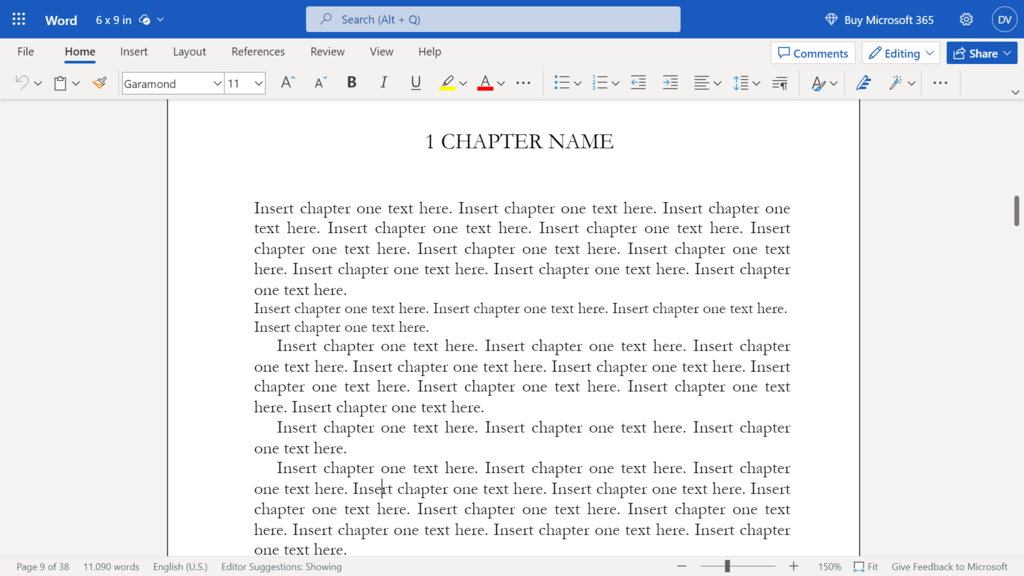
Open the docx file and edit the placeholder text. You’ll find all the sections you might need to prepare your book for publication, like the dedication, the copyright, a chapter list, an acknowledgments page, an author bio section, and, last but not least, some sample chapters to fill in.
If publishing your book on Amazon is the route you want to take and you have your heart set on editing your manuscript with MS Word, this is one of the best templates you can use. But it’s a bit basic and there’s still quite a lot of manual tweaking to do.
3. 48 Hour Books
📌 Key features:
- Platform: .dotx files for Word/OpenOffice/Pages
- Book Types: 4 popular formats
- Bonus: Free cover templates for Photoshop/InDesign
48 Hour Books is a book printing service based in Ohio that serves American and Canadian self-publishing authors, though their free book templates are open to everyone. Specifically, they provide .dotx files that you can open with word processing tools, like Microsoft Word, Open Office, or Pages, for 4 of the most popular book types.
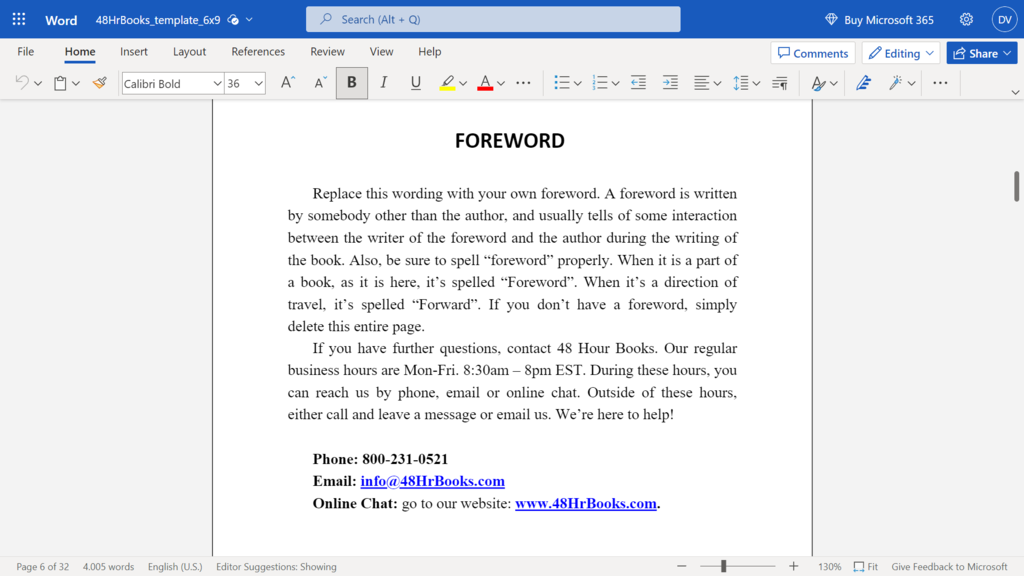
The template is well formatted and also includes various sections before the book’s content, like foreward, preface, and introduction. However, it promotes the company’s printing services on every other page, which is annoying since you’ll need to carefully edit that out.
Q: What are the most common mistakes authors make when self-publishing?
Suggested answer
From my conversations with self-publishing authors, here are some points came up most frequently:
- Cover design - trying to do it yourself if you don't have an understanding of design principles (or skimping by paying someone peanuts). Whether we like it or not, everyone is judging everything and everyone. First impressions count and good (exceptional) design, attracts attention. I myself have been known to purchase books just because of a gorgeous cover (and hoping the story will be as good!).
- Formatting - poor formatting will absolutely degrade all your efforts. Subconsciously, readers shouldn't be drawn to the layout. An exceptional one doesn't stand out (by way of - "There's something "off" with this layout"), and allows the reader to focus on the book content. Excellent formatting reflects an excellent product.
- Marketing - clearly defining who your target audience is, means you have clarity when it comes to creating your marketing content. It helps you market specifically to those most likely to purchase your book/s and develop a loyal following. Writing your book was one part of it. The marketing is as important to get it out into the world and it requires effort and a good understanding of what your specific book needs, so that it can garner the right attention.
- Audience - ignoring your audience and not engaging with them (or hearing their feedback), can be detrimental. They're your main source of importance when it comes to your reach. Truly understanding who they are (as above in marketing - your target audience), is crucial. They will want to engage with you and will reciprocate with loyalty.
- Procrastination and Perfectionism - this is probably one of the greatest issues we face (across humanity to be honest), and it's also a natural part of being human, that we must overcome. Learning how to optimize your time, carving out when you're most productive and sticking to it daily, and tracking when and how often you show up, creates your lifelong "good" habit. We want to weed out the bad habits that stop us from creating the work. Waiting for "the right time" is a fallacy and something that will blindly rob you of precious days, months and sometimes years. Show up for your future self now and develop the habits (over goals), that will compound over time and create the results needed. It's the actual action-taking that gives you clarity. You just need to start and keep going. Know one gets it right in the beginning. Just don't quit on yourself.
- Editing - after your hard work of bringing your book to life, this is an extremely important part of the writing process. We are so close to the work that we can easily miss what is right in front of us. A professional editor can whip you into shape and saving you time, effort and will elevate the quality exponentially.
The way to success is to never give up. Remember why you are doing it and enjoy the process!
Leoni is available to hire on Reedsy ⏺
Something I have seen quite a lot lately in the self-publishing world: trying to do everything by yourself. Thinking that you just need Photoshop to make a cover, spell-checking software to edit, a dictionary and a bit of knowledge to translate. Never underestimate the value of a human professional who has spent years studying and then honing their skills. There is more to translation than substituting one word with another, just as there is more to a cover than a bunch of drawings and a title.
Find the right professional for you and your project, and work closely with them; you won't regret the expense, I promise. Also, yes, some types of stories and tropes are very popular right now, and those seem like a safe bet, as far as marketing and selling go - but likely there are a lot of similar books out already. In traditional publishing, variety is sorely lacking, because a tried and tested product seems safer; let's avoid repeating that mistake. Write the story that's in your heart and then strategically find your niche audience. You'll find them starved for exactly your flavour of creativity.
Mariafelicia is available to hire on Reedsy ⏺
One of the most common mistakes I see with self-published authors is setting unrealistic timelines for their publishing journey. Many writers plan their schedule far too tightly and only reach out to professionals—whether editors, designers, or marketers—at the very last minute.
This creates unnecessary stress on both sides: the author feels rushed and overwhelmed, while the professionals either have to decline the project or take it on under less-than-ideal conditions. In the worst case, authors struggle to even find available professionals because their preferred timeline doesn’t allow for the necessary lead time. Many professionals book out months in advance, so it’s wise to plan at least four months ahead—and in many cases, even that may not be enough time.
It’s also important to remember: as self-publishers, you are free to set your own pace. Unlike in traditional publishing, there is usually no external deadline or audience impatiently waiting for the book—especially when it’s a debut. That pressure often comes only from a self-imposed timeline. Instead of rushing, it’s far wiser to take the time to do everything properly, work with professionals without stress, and then launch the book when it’s truly ready.
Publishing a professional-quality book requires space for collaboration, revisions, and creative breathing room. When timelines are compressed, the process becomes about “getting it done” rather than “getting it right,” which can ultimately compromise the quality of the finished book. A thoughtful, realistic schedule not only reduces stress but also ensures that every stage of the process—from editing to design—has the attention it deserves.
Sabrina is available to hire on Reedsy ⏺
One of the biggest traps authors fall into when self-publishing is thinking that the hard part ends once the book is written.
In reality, self-publishing is as much about production as it is about creativity, and overlooking that side can leave even the best manuscript looking unprofessional.
I’ve seen too many writers skip professional editing, try to design their own cover, or leave marketing as an afterthought, and the results are usually disappointing. But just as important, and often less discussed, are the mistakes around the actual printing and publishing process. Authors frequently go with the first printer they find rather than getting at least three quotes, which is a sure way to overpay.
Others don’t ask whether VAT will be added on top of the quoted price, only to discover the true cost later.
Perhaps the most heartbreaking mistake is not asking to see samples of the paper and materials being used; the author waits excitedly for their book to arrive, only to be handed a flimsy volume on cheap stock that feels nothing like the work they poured their heart into.
The truth is, self-publishing is about producing a product as much as sharing a story. Taking the time to ask questions, compare options, and insist on seeing exactly what you’ll be paying for can mean the difference between a book that looks like an amateur project and one you’re genuinely proud to hold in your hands and which reflects the hard work you have put in as well as the hopes, naturally enough, of your client to hold a book in their hands which is a quality item.
Edward is available to hire on Reedsy ⏺
I've read a fair number of self-published books, and one thing I have noticed is that an unprofessional interior book design does impact my reading experience.
Interior book design is about all that invisible work that makes a book visually pleasant to read. If the lines break poorly, if the font is too big or too small, if the line spacing is too tight or too loose, if the font selection is one that's difficult on the eyes, especially after reading for a long time--all of this will subtly make your reader tired while reading, and, perhaps subconsciously, less likely to enjoy reading your book. They might not even know why! And by the end, they may be left with this feeling that they didn't want to pick up the book to read it as much as they have other books, which is not a feeling you want your readers to have, especially for something so easily fixable.
A well typeset book is unnoticeable. That's the point! Your reader doesn't notice the words on the page. Instead, they glide over them, immersed in the story. But a poorly typeset book stands out. Your reader's attention is pulled from the story again and again because the words are too squished together to read easily, or because there was one dangling line all by itself on the last page of a chapter and that looked odd, or because the font for the text messages was inconsistently applied.
Interior book design is an important part of the publishing process that I think a lot of self-publishing authors overlook.
Emily is available to hire on Reedsy ⏺
Two mistakes I've encountered through my work with self-publishing authors are definitely common, but perhaps not super obvious at first thought.
Mistake #1: Hoping to ultimately publish with a traditional publisher, but self-publishing first as a means to “test things out.”
Self-publishing should be a conscious and very intentional choice that you make because the process appeals to you, not something you do as a test drive. Once it’s published, it’s published. In fact, as a former slush pile evaluator, I quickly learned that a previously-self-published submitted manuscript was often a no-go for the publisher I worked with. Why? Well, any self-published copies of the book that had been already sold are sales the publisher might have otherwise been able to count on — chances are, if you’ve self-published your book, you’ve already gotten all your friends and family to purchase a copy. Those are all opportunities for sales no longer open to the publisher. So, if you want to self-publish, that's great! But make sure that, whatever you decide on, you're making an intentional and conscious choice.
Mistake #2: Consider your use of copyrighted works and get permission!
This applies to nonfiction and fiction works alike: If you are including previously published content in your book, do your research and understand what may require permission to use. If you're including lengthy quotations or extracts from books, short quotations to open your book chapters (i.e., epigraphs), song lyrics (yes, even just one line of a song), poetry, or photographs/artwork, you will need to seek permission clearance from the copyright holder to legally include that content in nearly all cases. I can tell you, based on several years of experience in permissions editing, that the process of figuring out who the copyright holder is, applying for clearance, hearing back, and finalizing the clearance can take MONTHS. And you may not even be granted permission, after all that effort! It can also be very expensive — publishing companies and record labels especially will charge you per usage and based on the amount you've used. So, do your research, know the risks, and decide accordingly.
Lesley-anne is available to hire on Reedsy ⏺
The most common mistakes authors make when self-publishing are: 1) Not focus-group testing yout title and subtitle, Check with Amazon for duplicate titles, and ask friends/colleagues 2) Not obtaining at least 2 endorsements, for front and back cover. 3) Not creating a publisher name for themselves Amazon. If you publish under your personal Amazon account, the "publisher" will be listed as "independently published," which can erode credibility. Instead, set up your KDP account in the name of a publisher you invent. There are many more, like poorly-designed covers and interiors, but these are of the most overlooked.
Michael is available to hire on Reedsy ⏺
Common mistakes:
Unrealistic or distorted view of public interest (Harsh, I know.)
Family and friends aren't fans--neither are paid reviews. It is important to be as objective as possible when assessing your book's popularity. I say this because many indie and early-stage authors believe they need what NY Times BEst Selling authors need, and that can lead to a lot of wasted time and money.
Acting as your own publishing company
It may seem like creating a separate name as your "publishing company" but the reality is, you don't yet have a company. This can be misleading to actual publishers that may be interested or contribute to the mistake mentioned above. These days, authentically doing everything on your own is more appealing to readers and publishers than the "fake it 'til you make it" strategy.
Starting a blog
If you aren't ready to commit to a regular schedule or writing blogs in batches, you don't need a blog on your website. Focus more on a simple and clear website and point of sale, then drive traffic to it. A blog isn't going to get you traffic unless you treat the blog itself as a business of its own.
Chad is available to hire on Reedsy ⏺
On their site, they also offer book cover templates for the same book sizes, with different files depending on your book's word count, which can be edited in Photoshop and inDesign. Again, they offer to put together the cover with your manuscript and “add a spine” at no cost 一 that is, if you print with them. Unless you want to do that, we wouldn’t recommend using this template, as there are simpler and better solutions, like those mentioned above.
4. BookBaby
📌 Key features:
- Platform: Written instructions only (no actual template files)
- Format Options: 13 different trim size specifications
- File Type: Page setup guidelines for manual configuration
- Software Required: Any word processor (user must build from scratch)
Finally, BookBaby also offers free book templates among its publishing and printing-related services. They offer 13 different templates for different trim sizes, from the classic novel book format, to comic books, to picture books and many others.
However, there is a caveat: their template is actually just a page of instructions on how to set up the page layout and margin for your chosen format. For example, they write “Click the Paper tab to adjust your page size. Enter in 6.25” for the width and 9.25” for the height. Your book will be trimmed to 6” x 9” when finished.”
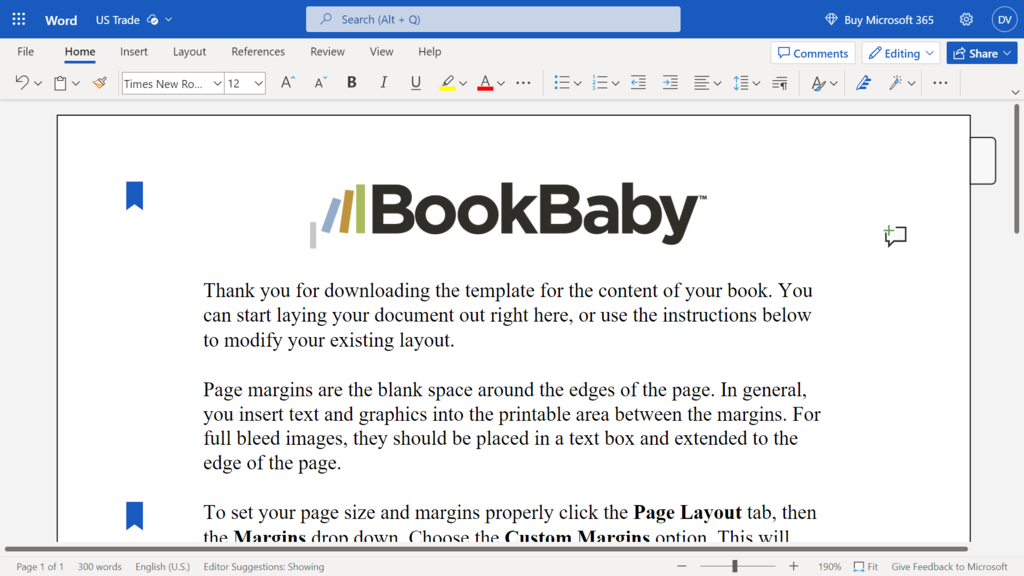
Since there are plenty of resources to learn how to design your book layout, and most authors are looking to simply replace the placeholder text with their manuscript, this is probably the least useful of the bunch, because it involves the most work.
In most cases, you should be able to typeset your novel with one of the other free templates mentioned above. That said, some projects have a slightly more intricate interior design, and require the help of experienced typesetters.
Q: What are the key red flags authors should look out for when approached by a vanity press?
Suggested answer
Spotting the red flags when dealing with a vanity press can save you a lot of headaches (and money!). Here are some key things to watch for:
- Upfront Fees: If they’re asking you to shell out big bucks to publish your work, it’s a major red flag. Legitimate publishers make money from selling books, not charging authors.
- Unrealistic Promises: Claims like “guaranteed bestseller” or “we’ll get you into every bookstore!” are major eye-roll territory. No one can promise that, and reputable publishers won’t even try.
- Accepting Anything: A real publisher is picky—they have to be since they invest in what they publish. If a press will take your book with zero hesitation (and no editing), chances are it’s more about your money than your talent.
- Vague Contracts or none at all: If the contract feels murky, confusing, or doesn’t make it clear what you’re getting and what rights you retain, that’s a huge red flag. Always know what you’re signing!
- Hidden Costs: Watch for surprise fees for “marketing,” “editing,” or “special services.” It’s a tactic used to squeeze more out of you once you’re already on the hook.
- Pushy Sales Tactics: If they’re coming at you hard with “limited-time offers” or pressuring you to sign fast, it’s a no-go. Legit publishers won’t need to convince you that hard.
- Shady Reputation: Do a quick online search. If you see lots of unhappy authors and stories of people feeling scammed, run the other way.
- Limited Distribution Claims: Be wary if their “distribution network” is mostly online listings without meaningful reach or promotion. Real publishers have genuine connections in the industry and established distribution channels.
- No Editing or Quality Control: If there’s no real editorial process or constructive input, it indicates they don’t care about the quality of your work—just about getting paid.
Bottom line is if it feels off or you’re seeing a bunch of these warning signs, trust your gut and dig deeper. Your work deserves better!
Eilidh is available to hire on Reedsy ⏺
I think we need to first distinguish between vanity presses and hybrid/independent publishers. There are legitimate publishers with a business model that includes an upfront payment from authors. This payment funds the production of the book, and then includes a royalty split in favor of the author, such as 70/30 or even 80/20.
Those are hybrid presses, which help keep much of the decision-making surrounding the book in the author's hands and provide a means for authors to benefit the most if the book sells well. They don't accept every book they are pitched, have quality standards that rival traditional publishers, and make money when more books are sold.
The hybrid model is different from a vanity press, which earns the bulk of its money from the pre-production and printing costs. Vanity presses rarely turn any author down who can pay for its services. Printing and design quality varies but you can still get a good-looking book from a vanity press, it will just be very expensive.
To know if you're dealing with a vanity press or a hybrid/independent press look for:
- Writers guidelines. Do they have any guidelines or will they publish anything?
- A sense of urgency. Vanity presses want to get you to commit and pay them money. This may lead to frequent emails, texts, and phone calls to inquire about the hold-up.
- Distribution details. Once your book is printed, how will the publisher get it into bookstores and, ultimately, readers? They should have a distribution partner, such as Simon & Schuster.
In addition to vanity presses, there are many, many scam operations that have cropped up offering to ghostwrite and publish your book for a couple thousand dollars. Be aware that you will likely get nothing, or next to nothing. Avoid these at all costs.
Scammers may have a legit-sounding company name but will lack any information about the founders and the team members who will be doing the work. They will feature gorgeous cover photos of books they never had anything do with producing, but which look impressive. They will feature "testimonials" and A+ Better Business Bureau (BBB) and TrustPilot ratings that are fake - type in the BBB and TrustPilot URLs yourself to check for the real reviews. And they, too, will hound you to sign on the dotted line and send them money.
If the deal being offered sounds too good to be true, it very likely is. Protect yourself.
But the reality is that few first-time authors will qualify for a traditional publishing deal that doesn't involve paying for production. This is because the Big 5 publishers are risk averse and want book deals from people who have huge platforms and social media follower counts. That is, they want to be almost assured that your book will be a bestseller, and few authors can guarantee that. Which is why hybrid publishing is a terrific alternative.
Marcia is available to hire on Reedsy ⏺
Unrealistic expectations. All vanity publishers can do is produce the physical book and get it onto sites like Amazon. They cannot guarantee any income from sales.
Andrew is available to hire on Reedsy ⏺
The easiest way to distinguish a scam publisher from a reputable hybrid publisher or self-publisher is PRICE. If a publishing firm quotes a fee of just a few thousand dollars for a service package that includes everything from copy editing, cover design, and layout to marketing and publicity—or even ghostwriting and developmental editing—you’re probably dealing with scammers. I know this from experience and from the fact that any single one of those services, when delivered by skilled and experienced professionals, usually costs more than a few thousand dollars. By contrast, the fees charged by the reputable hybrid publishers I know—companies with a track record of obtaining meaningful results for their authors—start in the $15,000 range. Several of my past clients made the mistake of opting for cut-rate vanity presses, and all of them came to regret it. When you hire a publisher that charges cut rates, you get cut-rate services in return.
Peter is available to hire on Reedsy ⏺
The fact that they're a vanity press is the only red flag you need. 😉 Seriously, though, I'd aim for either traditional publishing or full-on self-publishing. These companies who want you to go in on the costs are generally more trouble than they're worth. Caveat emptor.
Brett is available to hire on Reedsy ⏺
It's simple. If a "publisher" approaches you about "publishing" your work, and doesn't offer to write you a check, run away. Okay, that's a bit dramatic. But understand that a true publisher buys intellectual property from creators, Some authors choose to pay to have their book developed (cover, interior, ebook) for convenience. But be aware that you can find all those skills here on Reedsy for much less, and with more personal service.
Mike is available to hire on Reedsy ⏺
Generally, a red flag is when anyone approaches you and asks for funds upfront. This can be an agent or publisher. In general, legitimate agents and publishers have enough people approaching them without them having to pound the pavement to look for authors.
Attending writing conferences is one of the best ways to interact with legitimate agents and publishers. This is where they try to connect with authors directly and will not ask for money from the author.
Melody is available to hire on Reedsy ⏺
If that’s you, reach out to professional typesetter 一 they will help you meticulously prepare your book, guaranteeing that every aspect meets the highest standards.

Work with world-class designers on your book
The industry's best type-setters and designers are on Reedsy. Come meet them.
Learn how Reedsy can help you craft a beautiful book.
Hopefully, the resources shared in this post will help you create a stunning and professional-looking book and get you closer to the dream of publishing it. And if you're looking to dress your book with a nice cover, read the next post in our guide.
